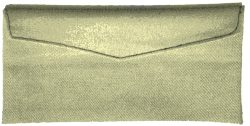
 |
home gallery |
| projects philosophy faq | |
 |
free plans: how to make a Cloth Envelope |
| Basic Description | This cloth envelope is a welcome retreat from the ordinary. In the free plan below, we'll show you how to make an envelope that helps elevate a letter well above standard pieces of mail. The recipient will immediately know that there is something special inside. Use them to mail invitations, letters, poems or anything you want to send to someone that is important to you. |
Affix the stamp as you ordinarily would. You can write the 'from' and 'to' addresses before you attach the mailing label, or you can prepare the envelopes in advance and easily write on the mailing labels after the envelope is completed. Sometimes it helps to temporarily slide something rigid into the envelope when you are writing on it. |
 |
We haven't had a problem mailing these envelopes. We're not sure how postal services, worldwide will view a cloth envelope. As long as it is rigid, securely sealed, and the address and stamp are in the proper place, we don't think you will have a problem. It is probably wisest, though, to send a test mailing, perhaps to yourself to confirm that your local postal service can process it. If you do run into any difficulty with the mailing, please let us know.
These are perfect whenever you have an important message. A cloth envelope immediately rises in importance when it is received. Recipients typically say that all of the other mail loses its significance in the presence of a cloth envelope. They can be used for an important letter, a note, a get-well, a card, an invitation, a poem, etc. Be creative!
design considerationsThe cloth envelope that we show in the plan is just a basic version; there are many options and embellishments that you can include. fabricYou can use any fabric you like but it should be durable enough to handle the rigors of the mail. If you are gluing on the mailing label, make sure that your glue works well on the fabric of choice. Some glues do not work well on heavily textured fabrics. If your fabric is flimsy, we recommend that you either put a rigid cardstock insert into the envelope or simply use rigid paper for your note or letter. This rigidity will make it much easier for the post office to handle. sizeThere are really no limitations to the size of the envelope. Keep in mind, though, that as you increase the size it becomes less rigid, so you may need to use a cardboard (or similar) insert. The post office also has restrictions on the size of letters, but we don't think that anyone is considering to make one that large! sealing the envelopeWe seal our envelopes by sewing in a few stitches along the flap of the envelope. You can also experiment with zippers, buttons, glue, double-sided tape, ribbon or string tied through button-holes, or wax. Whatever you choose, you should try a few tests and maybe a test mailing or two before you mail the final product. If privacy is an issue, you will have to stay away from using a zippers and buttons because anyone would be able to open and close the envelope without a sign. |
|
 |
© 2000-2008
terms privacy policy |
home gallery |
| projects philosophy faq | ||